).
C. frames
D. Messages
)
C. connectionless unreliable service
B. TCP and UDP
C. TCP and SMTP
D. ARP and DNS
A. connection oriented unreliable service
B 1. Which of the following services does not the transport layer provide for the application layer?
A. In-order delivery of data segments between processes B. Best effort delivery of data segments
between communicating hosts C. Multiplexing and demultiplexing of transport layer segments D.
Congestion control
A 2. What are the two of the most important protocols in the Internet?
A. TCP and IP
C 3. The Internet provides two services to its distributed applications: a connection oriented
reliable service and a (
B.
connectionless reliable service
D. In order data
transport service
D 4. Processes on two different end systems communicate with each other by exchanging (
across the computer network.
A. packets
B. datagram
A
5. The job of delivering the data in a transport-layer segment to the correct socket is called ().
A. demultiplexing
B. multiplexing
C. TDM
D. FDM
C6. Two important reasons that the Internet is organized as a hierarchy of networks for the purpos
es of routing are:
A. Least cost and maximum free circuit availability B. Message complexity and speed of
convergence C. Scale and administrative autonomy
B 7. Which of characters is not distance-vector algorithm’s characters?( )
A. iterative B. global C. asynchronous D. distributed
D 8. The length of IPV6 address is ( )bits.
A. 32 B. 48 C. 64 D. 128
C 9. The host component of a CIDR address of the form a.b.c.d/25 can contain addresses for:
A. 225 hosts (minus “special” hosts) B. 512 hosts (minus “special” hosts) C. 2(32-25) hosts
(minus “special” hosts) D. 25 hosts (minus “special” hosts)
C 10. The primary function of the address resolution protocol (ARP) that resides in Internet hosts
and
A. To provide LAN router functions
interface addresses C. To translate IP addresses to LAN addresses
D. To calculate the shortest path between two nodes on a LAN
A 11. The POP3
protocol runs over ____ and uses port ____
A. TCP 110
D 12.When a destination host
unambiguously
of:
A. Source port #, destination IP address, and source IP address
B. Destination port #, source port #, process ID#
C. Destination port #, source port #, destination IP address
D. Destination port #, source port #, source IP address
it
identifies the appropriate process to pass the data to by using a triplet consisting
B. To translate between LAN addresses and physical
transport
layer
receives data from the network layer,
D. Link cost changes and link failure
B. UDP 110
C. UDP 25 D. TCP 25
routers is:
�
the receiver’s buffer.
B. HTTP C. DNS
D. All of them
B. appointed
C. round-robin
D. uncirculated
B. TCP 36
C. UDP 53 D. TCP 53
B. application layer C. transport layer
D. the network layer
B. Destination Port # C. Source Port # D. Sequence #
D 13. From the list below, select the items found in the TCP segment structure that are not found
in the UDP segment structure:
A. Application Generated Data
A 14. The RIP routing protocol is based on an algorithm that is: A. Based on information
received only from link “neighbors” B. A link state algorithm C. An OSPF algorithm D. A
centralized routing algorithm
B 15. With an exterior routing protocol, which of the following issues generally dominates the
routing decisions?
A. Geographical distance between AS’s B. Policy C. Number of AS’s traversed D. Current
congestion levels in the AS’s
A 1. End system are connected together by ____.
A. communication links
C 2. Which application’s NOT using TCP?
A. SMTP
B 3. In the polling protocols, the master node polls each of the nodes in a/an ____ fashion.
A. random
C 4. The DNS protocol runs over ____ and uses port ____.
A. UDP 36
A 5. TCP provides a ____ service to its applications to eliminate the possibility of the sender
over-flowing
A. flow-control B. congestion control C. reliability control D. data connection
D 6. We can classify just about any multiple access protocol as belonging to one of three
categories: channel partitioning protocols, random access protocols, and ____.
A. address resolution protocols
link-control protocols
B 8. The maximum transfer unit(MTU) in Ethernet frame structure is ()byte .
A. 1000
B 9. The socket of UDP is identified by _____ and _______.
A. source IP address and source port number
number.
and source IP address.
C 10. Which is not plug and play in the following four items?
A. DHCP B. Hubs
D 11.Which of routers is not default routers ?
A. first-hop router B. source router
B 13. ICMP is_____.
A. the protocol of Application layer
protocol of transport layer
B 14. As general, we has following channel partitioning protocols except ____.
A. TDM
D 15. ____ is most used for error reporting.
A. UDP
B 16. The header of IPV6 is ____byte.
A. 20 B. 40 C. 60 D. 80
B. destination IP address and destination port
D. destination IP address
C. source IP address and destination port number.
C. destination router D. second-hop router
B. Dynamic host configuration protocols
B. the protocol of network layer C. the
B. CSMA
C. FDM
D.CDMA
B. SMTP
C. FTP
D. ICMP
D. not a part of TCP/IP protocols
C. Routers
D. Switches
D. taking-turns protocols
B. 1500
C. 800
D. 2000
C.
�
D. Modem
d)
d)
B 17. In the network layer these service are host-to-host service provided by ____. (B)
A. the transport layer to the network layer B. the network layer to the transport layer C. the
network layer to the network layer D. the transport layer to the transport layer
A 18. If there is not enough memory to buffer an incoming packet , a policy that drop the arriving
packet called ____.
A. drop-tail B. packet loss C. protocol D. encapsulation
C 19. In either case, a ____ receives routing protocol messages, which are used to configure its
forwarding table.
A. server B. host C. router
D 20. Which of the following functions does not belong to PPP___.
A. framing B. link-control protocols C. network-control protocols D. error correction
B 1. Which of the following services does the Internet network layer provide for the Internet
transport layer?
A. In-order delivery of data segments between processes
B. Best effort delivery of data segments between communicating hosts
C. Multiplexing and demultiplexing of transport layer segments
D. Congestion control
D 2. The main task of the Internet’s Domain Name System (DNS) is to:
A. Translate port numbers to IP addresses
B. Specify the standards for Internet domain names
C. Provide an authority for registering domain names
D. Translate mnemonic(记忆的) names to IP addresses
A 10. The FTP protocol runs over ____ and uses port ____.
A. TCP 21
C 3.RDT3.0 ’s receiver FSM is same to:
RDT2.0
B 4.The Transmission Control Protocol (TCP) provides which of the following services?
a) End-to-end station addressing b) Application multiplexing c) Inter network routing
Medium access control (MAC)
D 6.Given that the requested information is not available at any intermediate databases, a
non-iterated DNS query from a requesting host would follow the path:
a) Root name server, local name server, authoritative name server
b) Authoritative name server, root name server, host name server
c) Local name server, root name server, local name server, authoritative name server
e) Local name server, root name server, authoritative name server
A 8.lect the four essential steps, briefly described, for terminating a TCP connection between a
client and a server, assuming that the initiating host is the client:
(1) Client sends TCP segment with ACK0 and final sequence number
(2) Client sends TCP segment with FIN =1 and goes into FIN_WAIT state
(3) Server sends TCP segment to ACK the client’s FIN request and enters CLOSE_WAIT state
(4) Server sends TCP segment with FIN=0
(5) Server sends TCP segment with FIN=1
(6) Client sends TCP segment with to ACK server’s FIN and enters second FIN_WAIT state
(7) Client sends TCP segment with FIN=0
C. UDP 20 D. TCP 110
B. TCP 80
b) RDT2.1
c) RDT2.2
a)
RDT1.0
�
b) 5,1,2,3
c) 1,3,5,7
d)
2,3,4,6
a) 1110 b) 011010 c) 100101 d) 10011
c) Three fragments are created
d) The last fragment consists of exactly 300 bytes of data from the
a) 2,3,5,6
B 10.When compensating for link cost changes in the distance vector algorithm, it can generally
be said that:
a) Increased costs are propagated quickly, i.e., “bad news” travels fast
b) Decreased costs are propagated rapidly, i.e., “good news” travels fast
c) Decreased costs do not converge
d) None of the above
B 14.As an IP datagram travels from its source to its destination:
a) the source IP address is changed at each router to identify the sending router
b) the router uses the destination IP address to consult its routing table
c) the router does not use the IP addresses in the datagram
d) the destination IP address is changed at each router to reflect the next hop
C 15.From the list below, choose the bit pattern which could be a valid generator value for the
CRC code (R
) 11010:
A 16.Consider sending a 1300 byte IPv4 datagram into a link that has an MTU of 500 bytes:
a) Three fragments are created. b) Four fragments are created.
with offsets 0, 500 1000
original datagram
C 17.Suppose one IPv6 router wants to send a datagram to another IPv6 router, but the two are
connected together via an intervening IPv4 router. If the two routers use tunneling, then:
a) The sending IPv6 router creates an IPv4 datagram and puts it in the data field of an IPv6
datagram.
b) The sending IPv6 router creates one or more IPv6 fragments, none of which is larger than the
maximum size of an IPv4 datagram.
c) The sending IPv6 router creates an IPv6 datagram and puts it in the data field of an IPv4
datagram.
d) The sending IPv6 router creates an IPv6 datagram and intervening IPv4 router will reject the
IPv6 datagram
D 18.Which of the following was an important consideration in the design of IPv6
a) fixed length 40-byte header and specified options to decrease processing time at IPv6 nodes
b) 128-bit addresses to extend the address space
c) different types of service (flows) defined
d) all of the above
D 19.A network bridge table is used to perform the following:
b) Forwarding frames directly to outbound
a) Mapping MAC addresses to bridge port numbers
ports for MAC addresses it handles c) Filtering (discarding) frames that are not destined for MAC
addresses it handles d) All of the above
PART Ⅱ: True / False
1. The DNS server can update the records.
2. The TCP connection is a direct virtual pipe between the client ’s socket and the server ’s
connection socket.
3. SMTP protocol connect the sender’s mail server and receiver’s mail server
4. Whereas a transport-layer protocol provides logical communication between processes running
(1 points per question – total:20 points)
(T)
(T)
(T)
�
(T)
(F)
( F )
( T )
T
(T)
the earliest intra_AS Internet routing protocols.
F
on different hosts, a network-layer protocol provides logical communication between hosts.
(T)
5. UDP and TCP also provide integrity checking by including right-detection fields in their
headers.
6. If the application developer chooses UDP instead of TCP, then the application is not directly
talking with IP.
7. When we develop a new application, we must assign the application a port number.
( T )
8. Real-tine applications, like Internet phone and video conferencing, react very poorly to TCP’s
congestion control.
9. The sender knows that a received ACK or NAK packet was generated in response to its most
recently transmitted data packet.
10. To simplify terminology, when in an Internet context, we refer to the 4-PDU as a unit.
(F)
11. DV algorithm is essentially the only routing algorithm used in practice today in the Internet。(F)
12. Every router has many forwarding tables. (F)
13.In either case, a server receives routing protocol messages,which are used to configure its
forwarding table. (F)
14.Among the ASs, they run the same inter_AS routing protocol.
15.Routing protocols ’ job is to determine the path take by a datagram between source and
destination.
T
16.OSPF was one of
17.The IPV6 datagrams are more simpler, more streamlined.
18.Forwarding tables in datagram networks can be modified at any time.(T)
19.In a VC network, the network ’s routers must maintain connection state information for the
ongoing connections.(T)
20.The routers of datagram networks use forwarding table, the routers of virtual-circuit networks
don’t use forwarding table.(F)
PART Ⅱ: Briefly answer the following questions.
1. In the “10BaseT”,T stands for (
). (twisted pair)
2. (
( TCP) ( IP)
3. In a client-server architecture, there is an always-on host , called the (
requests from many other hosts, called (
4. The broadcast destination IP address is (
5. Two of the more important (
(taking-turns)
6. Transport-layer protocols are implemented in the (
system)
7. The port numbers ranging (
8.The (
RIP and BGP, Novell IPX, and the original ARPAnet.
9. Internet consists of hierarchy of interconnected (
10. In MAC address, broadcast address is (
).
11. AS is a collection of(
12. (
bandwidth among all nodes sharing that channel. (TDM)
(routers)
) and FDM are two techniques that can be used to partition a broadcast channel’s
algorithm is used in many routing protocols in practices, including the Internet’s
(DV /distance-vector)
).
(FF-FF-FF-FF-FF-FF)
(ISPs)
)
protocols are polling protocols and token-passing protocol.
) are two of the most important protocols in the internet.
) under the same administrative and technical control.
).
).
(server)(clients)
(255.255.255.255)
) and (
)
), which services
), but not in network router. (end
) are called well-known port numbers. (0~1023)
�
(packet loss)
)
) from a sending host to a receiving host.
(link)
). (best-effort service)
(frames)
).
include PCs, workstations, Web servers, mail
(NOTE: include the protocol data unit)
) refers to the router-local action of transferring a packet from an input link interface to
13. As the queues grow large, the router’s buffer space will eventually be exhausted and (
packet loss will occur.
14. The role of the network layer is to move (
(packets)
15. (
the appropriate output link interface. (Forwarding)
16. The Internet’s network layer provides asingle service,known as (
17. The units of data exchanged by a link-layer protocol are called (
18. The (
) -layer protocol defines the format of the packets exchanged between the nodes at
the ends of the link, as well as the actions taken by these nodes when the packets are sent and
received.
1.(3points) What is the difference between a host and end system? List the types
of end systems. Is a Web Server an end system?
答:There is no difference. Throughout this text, the words “host” and “end system” are used
interchangeably. End systems
servers,
Internet-connected PDAs, WebTVs, etc.
1.(1points) Why is there a Web cache?
答:减少接入网络的流量、减小延迟
2.(3points) Please briefly describe the function of the five layers in TCP/IP
architecture
答: 1.应用层,提供各种网络应用,运行网络应用程序。Message。 2.运输层,提供端
到端进程之间的数据传输。Segment。 3.网络层,主机到主机的传输。Datagram 4.链路
层,相邻节电数据传输,frame 5.物理层,透明传输比特流,bit stream.
3. (2points) What are the services of TCP?
答 : connection-oriented service;
congestion control:
4. (2points) Please briefly compare: datagram network versus virtual circuit (VC)
network.
答:数据报网络是面向非连接的服务,不可靠的服务,没有流量控制和拥塞控制。 虚电路
网络是面向连接的网络,可以提供可靠的传输服务,具有流量控制和拥塞控制。
5. (2points) What is the difference between routing and forwarding?
答:Forwarding is about moving a packet from a router’s input link to the appropriate output link.
Routing is about determining the end-to-routes between sources and destinations.
6. (3points) How big is MAC address space? The IPv4 address space? The IPv6
address space? 答:MAC: 248,IPv4:232;IPv6:2128
7. (4points) Fill in the blank:
1) RIP advertisements typically announce the number of (
BGP updates announce the (
ASs
protocol, sequence number space >=(
ALOHA =(
8. (2points)Consider sending M packets over a path of N links. Assume that each
packet has L bits. Each link transmits at R bps. The network is lightly loaded so
that there are no queuing delays. Propagation delay and node processing delay
are negligible. Suppose the network is a packet-switched datagram network and
2)
3) For Selective Repeat
)times window size. 4) The efficiency of Slotted
reliable, in-order byte-stream data transfer flow control:
hops
) to various destinations.
) to various destinations
2
2
) times bigger than Pure ALOHA.
�
a connectionless service is used. Now suppose each packet has 2h bits of header.
How long does it take to send the packet? (all packets go through the same path)
答: (N+M-1)*(L + 2h) / R
9. (2points)If all the links in the Internet were to provide the reliable delivery
service, would the TCP reliable delivery service be redundant? Why or Why not?
答: Although each link guarantees that an IP datagram sent over the link will be received at the
other end of the link without errors, it is not guaranteed that IP datagrams will arrive at the
ultimate destination in the proper order. With IP, datagrams in the same TCP connection can take
different routes in the network, and therefore arrive out of order. TCP is still needed to provide the
receiving end of the application the byte stream in the correct order. Also, IP can lose packets due
to routing loops or equipment failures.
3. (3points) 3. (3points) Consider accessing your email with POP. Suppose you
have configured your pop mail client to operate in the down-load-and-delete
mode. Complete the following transaction.
C: list
S: 1 498
S: 2 912
S: .
C: retr 1
S: blah blah …
S: …………blah
S: . ? ? ?
答:C: dele 1
S: (blah blah … S: ………..blah)
S: .
C: dele 2
C: quit
4. (3points) Where can queuing occur in a router? Briefly explain the conditions
that lead to such queuing.
答:Queuing can occur at both the input ports and the output ports of a router. Queuing occurs at
the output port when the arriving rate of packets to the outgoing link exceeds the link capacity.
Queue occurs on an input port when the arriving rate of packets exceeds the switch capacity;
head-of-the-line blocking can also cause queuing at the input ports.
5. (3points) Describe why an application developer might choose to run an
application over UDP rather than TCP.
答:An application developer may not want its application to use TCP’s congestion control, which
can throttle the application’s sending rate at times of congestion. Often, designers of IP telephony
and IP videoconference applications choose to run their applications over UDP because they want
to avoid TCP’s congestion control. Also, some applications do not need the reliable data transfer
provided by TCP.
6. (3points) Suppose Client A initiates a Telnet session with Server S. At about
the same time, Client B also initiates a Telnet session with Server S. Provide
possible source and destination port number for
a. The segments sent from A to S
�
hops
) to various destinations.
2
) times bigger than Pure ALOHA.
) to various destinations
2
2)
3) For Selective Repeat
)times window size. 4) The efficiency of Slotted
b. The segments sent from B to S
c. The segments sent from S to A
d. The segments sent from S to B
e. If A and B are different hosts, is it possible that the source port number in the
segments from A to S is the same as that from B to S?
f. How about if they are the same host?
答:source port
numbers
destination port
Numbers
a. A →S 467 23
b. B →S 513 23
c. S →A 23 467
d. S →B 23 513
e. yes f. no
7. (4points) Fill in the blank:
1) RIP advertisements typically announce the number of (
BGP updates announce the (
ASs
protocol, sequence number space >=(
ALOHA =(
8. (3points)Consider sending a packet over a path of N links. Assume that each
packet has L bits. Each link transmits at R bps. The network is lightly loaded so
that there are no queuing delays. Propagation delay and node processing delay
are negligible. Suppose the network is a packet-switched datagram network and
a connectionless service is used. Now suppose each packet has 2h bits of header.
How long does it take to send the packet?
答: (L+2h)/R*N
9. (3points)If all the links in the Internet were to provide the reliable delivery
service, would the TCP reliable delivery service be redundant? Why or Why not?
答: Although each link guarantees that an IP datagram sent over the link will be received at the
other end of the link without errors, it is not guaranteed that IP datagrams will arrive at the
ultimate destination in the proper order. With IP, datagrams in the same TCP connection can take
different routes in the network, and therefore arrive out of order. TCP is still needed to provide the
receiving end of the application the byte stream in the correct order. Also, IP can lose packets due
to routing loops or equipment failures.
10. (Total 4 points)CDMA
Suppose that four nodes using CDMA (Code Division Multiple Access) protocol to transport their
data. The chipping sequences are listed respectively as below:
A: (-1,+1,–1,+1,+1,+1,–1,-1)
B: (-1, +1,–1, –1,–1,–1, +1,-1)
C: (-1,–1,–1,+1,+1,–1,+1,+1)
D: (-1,–1,+1,–1,+1,+1,+1,-1)
(Computing process is needless)
�
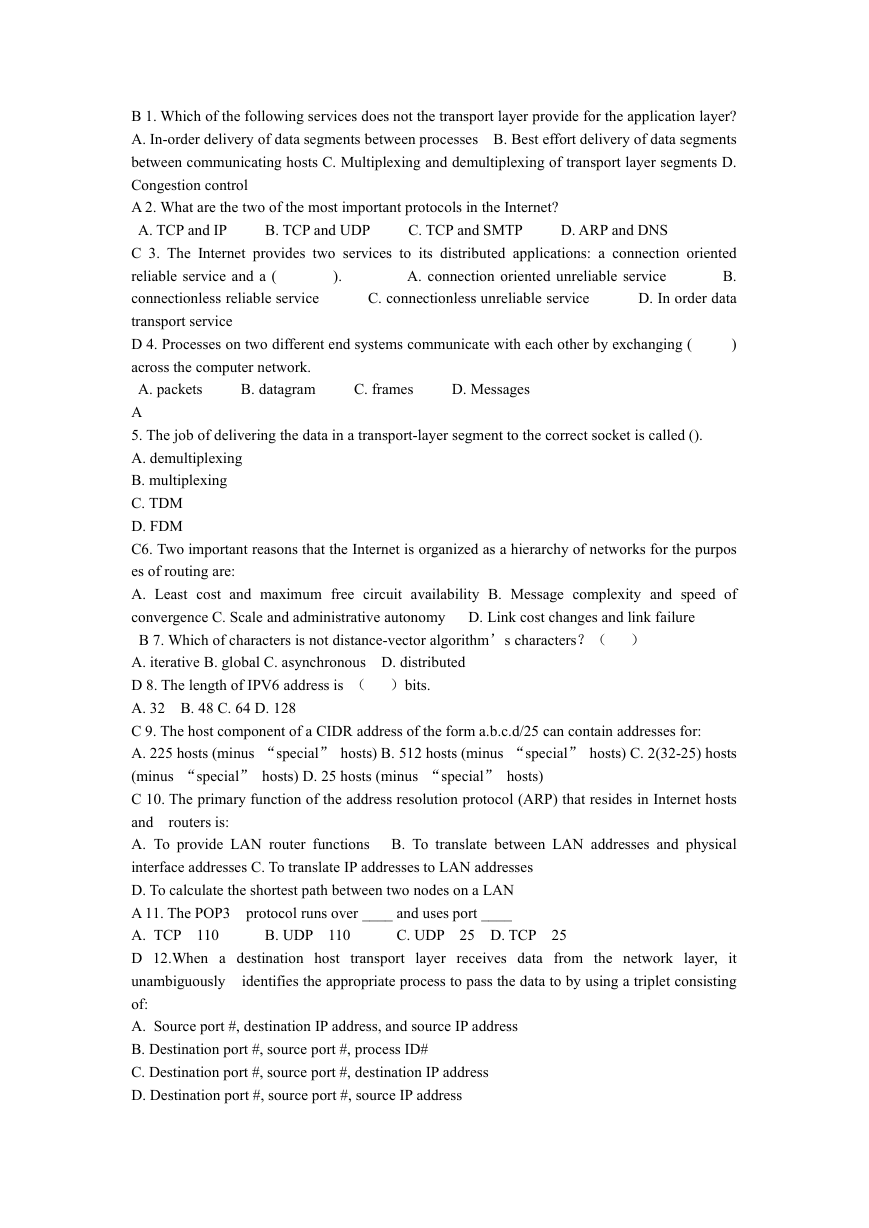
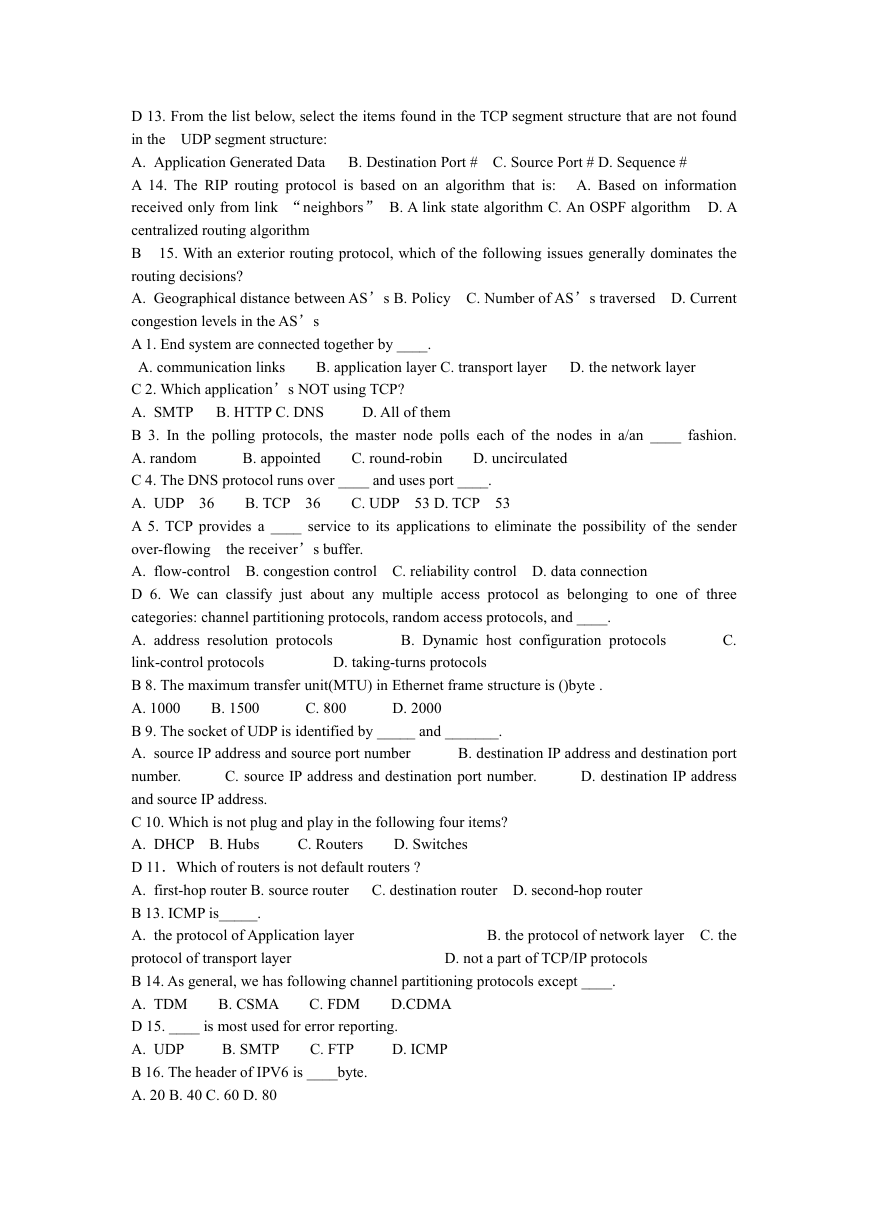
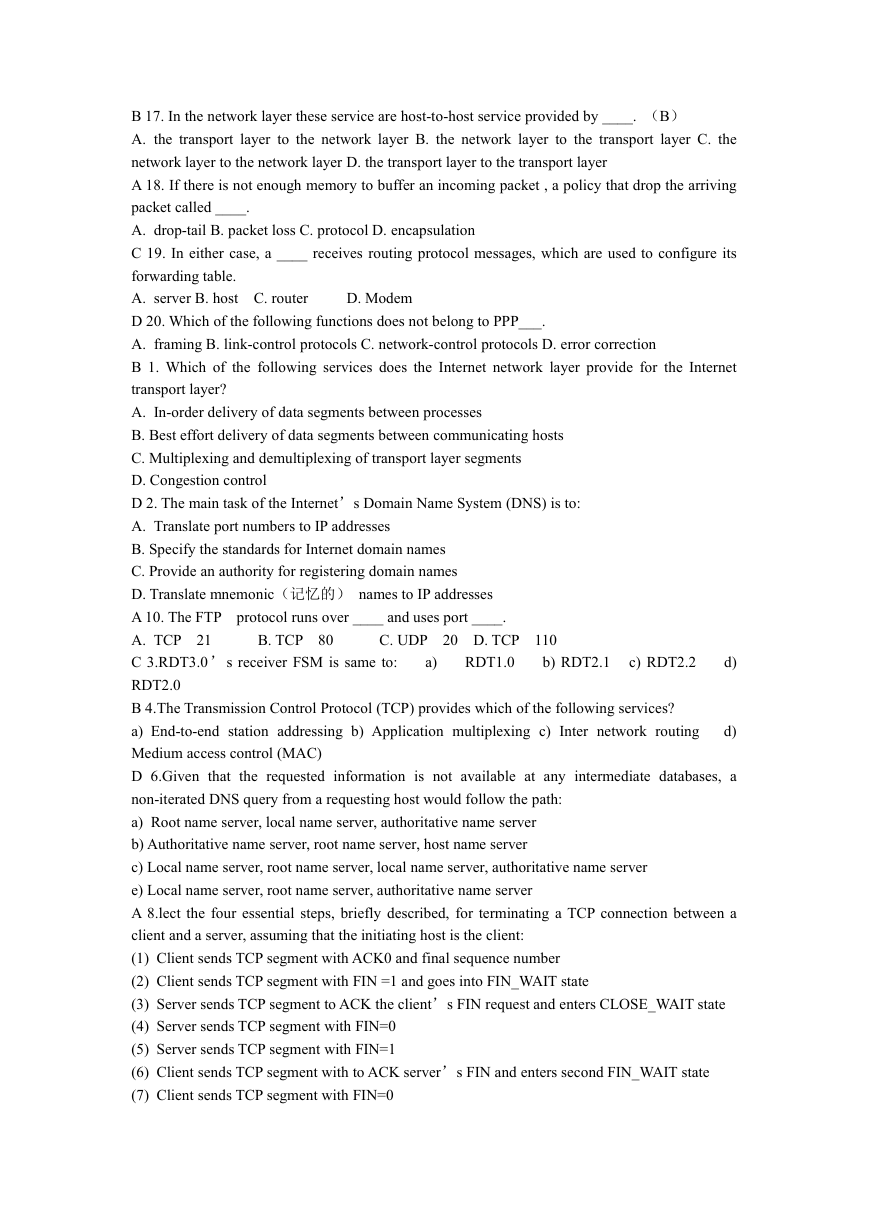


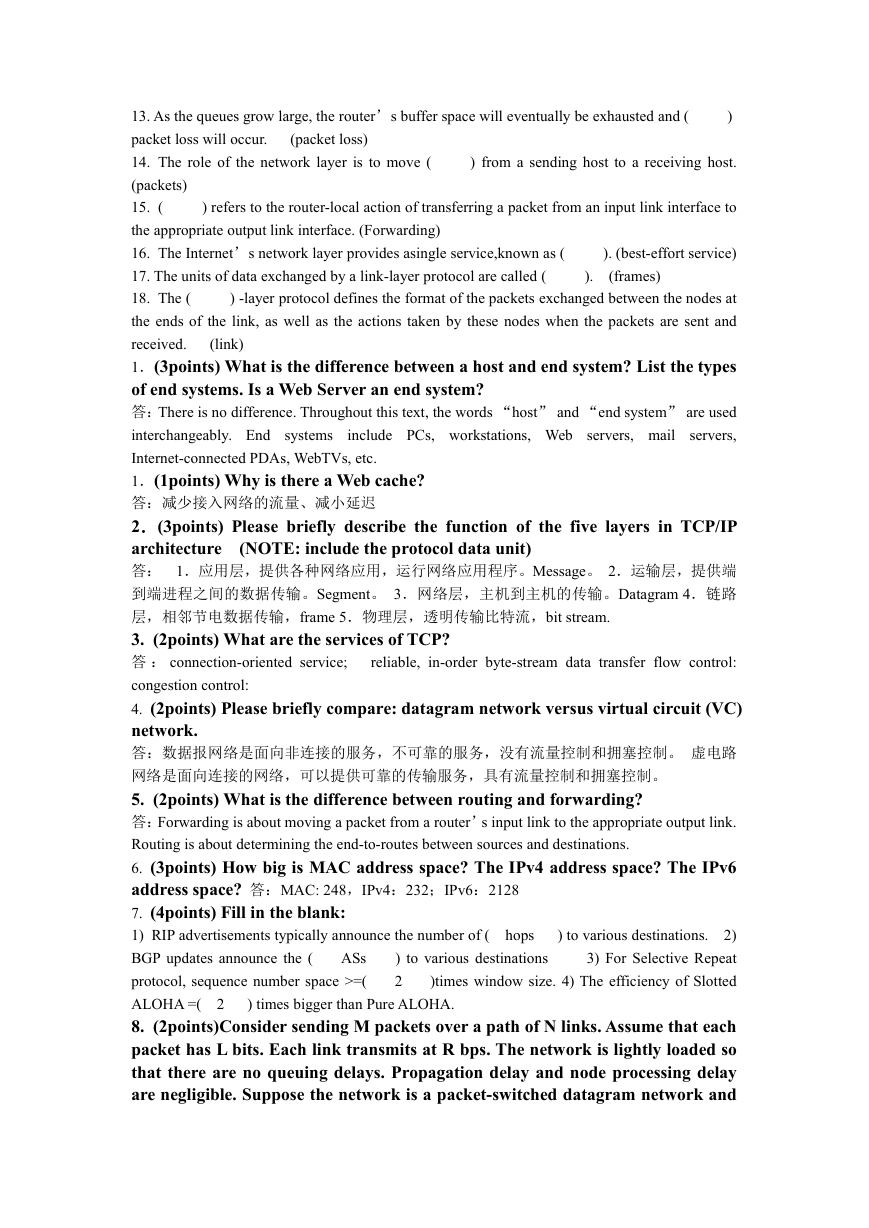

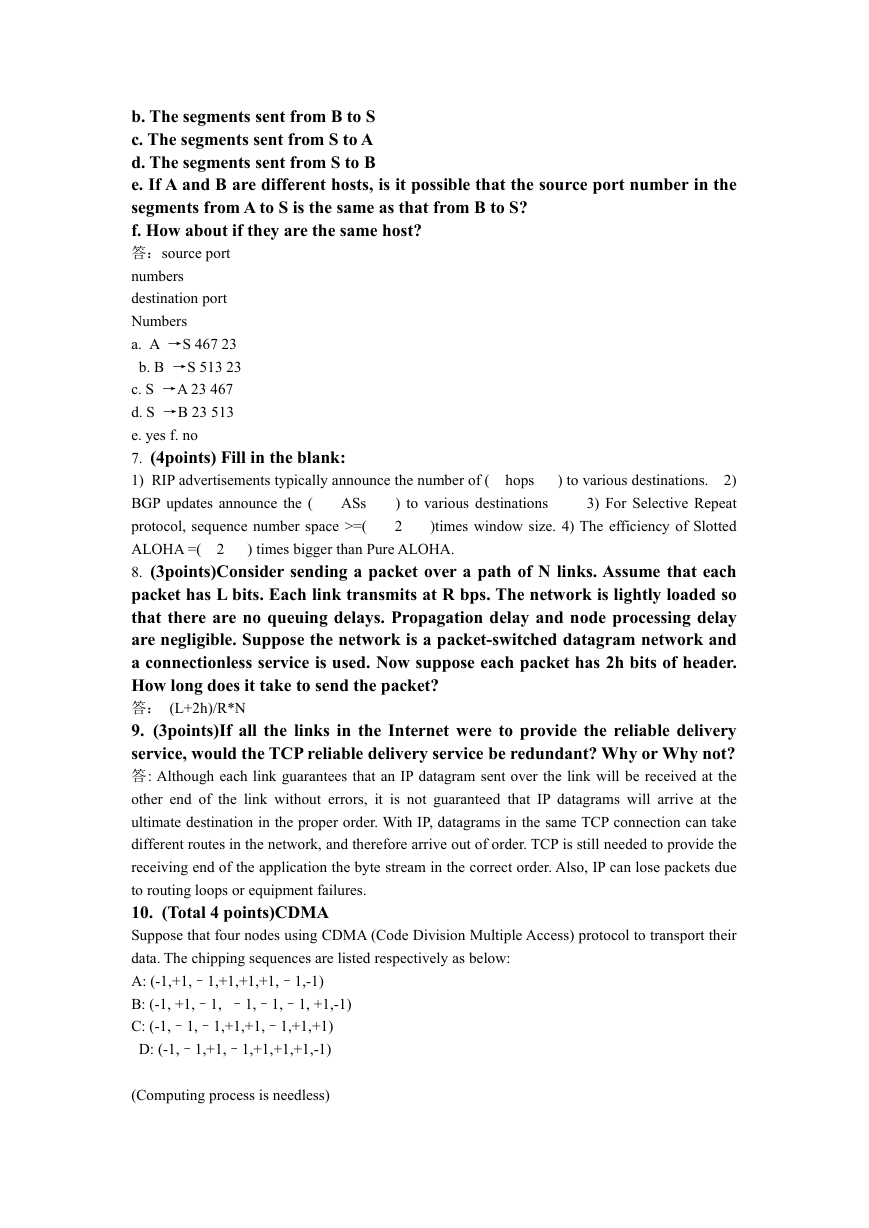








 2023年江西萍乡中考道德与法治真题及答案.doc
2023年江西萍乡中考道德与法治真题及答案.doc 2012年重庆南川中考生物真题及答案.doc
2012年重庆南川中考生物真题及答案.doc 2013年江西师范大学地理学综合及文艺理论基础考研真题.doc
2013年江西师范大学地理学综合及文艺理论基础考研真题.doc 2020年四川甘孜小升初语文真题及答案I卷.doc
2020年四川甘孜小升初语文真题及答案I卷.doc 2020年注册岩土工程师专业基础考试真题及答案.doc
2020年注册岩土工程师专业基础考试真题及答案.doc 2023-2024学年福建省厦门市九年级上学期数学月考试题及答案.doc
2023-2024学年福建省厦门市九年级上学期数学月考试题及答案.doc 2021-2022学年辽宁省沈阳市大东区九年级上学期语文期末试题及答案.doc
2021-2022学年辽宁省沈阳市大东区九年级上学期语文期末试题及答案.doc 2022-2023学年北京东城区初三第一学期物理期末试卷及答案.doc
2022-2023学年北京东城区初三第一学期物理期末试卷及答案.doc 2018上半年江西教师资格初中地理学科知识与教学能力真题及答案.doc
2018上半年江西教师资格初中地理学科知识与教学能力真题及答案.doc 2012年河北国家公务员申论考试真题及答案-省级.doc
2012年河北国家公务员申论考试真题及答案-省级.doc 2020-2021学年江苏省扬州市江都区邵樊片九年级上学期数学第一次质量检测试题及答案.doc
2020-2021学年江苏省扬州市江都区邵樊片九年级上学期数学第一次质量检测试题及答案.doc 2022下半年黑龙江教师资格证中学综合素质真题及答案.doc
2022下半年黑龙江教师资格证中学综合素质真题及答案.doc